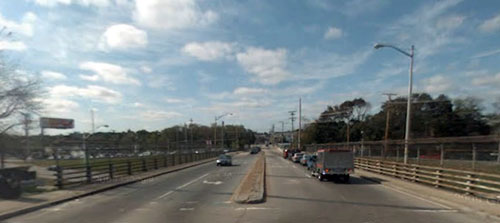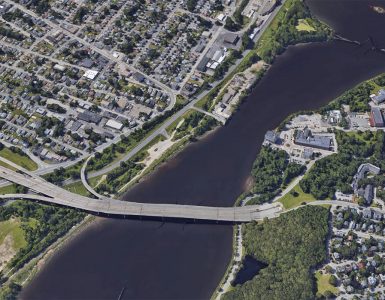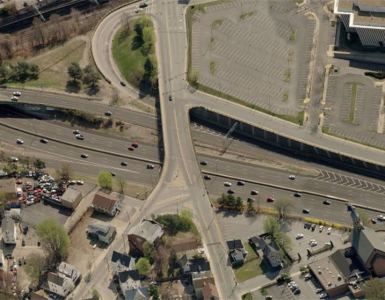
Image from Google Maps
Rhode Island Bicycle Coalition posted an update on the Union Avenue Bridge.
They asked RIDOT if there was any accomodation for cyclists in the new bridge design and were told:
The new Union Ave bridge will have the same design configuration as the old Union Ave bridge. There will be a 2 foot median, 2- 11 foot travel lanes, a one foot shoulder, and a 6 foot sidewalk, in each direction (Eastbound & Westbound). There is no special accomodation for bicycles on this bridge. Bicyclists will have to follow the standard traffic laws.
When asked if the design could be changed to allow for bike lanes, a RIDOT spokesperson said it was too late and would be too expensive to change the design now.
It would likely be prohibitively expensive, and slow the work schedule, to redesign the bridge at this point to accomodate full bike lanes. The actual structure would need to be made wider. Of course it should have been designed with bikes in mind from the get go, but as described, I would think it is possible to accomodate bikes somehow.
First let me just say this about the design. 46 feet for automobiles and 12 feet for pedestrians, really? RIDOT, get with it, this is a city, people walk here.
OK, I would start with getting rid of the median. Medians separate traffic and often cause cars to move faster, since there is a barrier between them. Having only a double yellow line puts opposing traffic closer together and drivers slow down.
So with that there’s now 2 feet to play with. My understanding is that Rhode Island law allows bikes on sidewalks (or does not expressly prohibit bikes on sidewalks). As a pedestrian, I’m not really on board with that, but if it makes bikers safer at this crossing, I’m willing to go with it. Simply adding that 2 feet from the median makes each sidewalk 7 feet wide now, giving slightly more room for bikes and pedestrians to coexist on them.
But I wouldn’t stop there, at 11′, the travel lanes for the cars are on the wide side, interstate standard is 12′ and Union Avenue is not an interstate. The lanes could be dropped to 10′ or 9.5′. If the lane widths dropped to 10 feet, that would give us 4 more feet to play with, allowing for 10 foot sidewalks.
Alternately, the sidewalks could be kept at the original 6 feet, the center lanes used for left turns, could be 9.5 feet, then the outside lanes could be 13.5 feet wide, with Sharrows painted on them for bike accomodation.
Or, there doesn’t need to be 4 traffic lanes at all, on either end of the bridge, Union Avenue is only 2 lanes wide. Make three 10′ lanes with the center lane divided into left turn lanes for either direction at either end. That leaves us with 30′ for cars, 12′ for sidewalks, and 16′ for bike lanes. Since bike lanes should be 4-5′ wide, we’d have planety of room for the bike lanes to be protected from the traffic lanes.
Yes, at this point, any of these changes would cost RIDOT some money (if only to pay an engineer to draw them up), would likely have some degree of impact on the schedule, and would be subject to review of the contractor’s quote (different configurations use different amounts of material, etc.) but it would not be impossible even at this late date to reconfigure what actually is placed on the 58′ road deck. In fact, aside from removing the median (which should be a cost savings I would imagine) most of these options are simply a matter of paint on the roadway.
And seeing as it is simply a matter of paint on the roadways, this is something that is possible on other bridges in the area. Atwells Avenue comes to mind (both the Route 95 and Route 10 bridges).
I’ve said it before, I think RIDOT is starting to move in a good direction as far as livable streets are concenred under the direction of Micheal Lewis, but it is taking too long to make the change in internal culture they need to make, they need to step it up! We can’t keep building bad bridges and thinking, “well, the next one we’ll build right.”





I live in this area & don’t mind to have bike lanes on this bridge. It’s a strategic crossing that provides easy access to a freeway as well as connects neighborhoods. In order to accommodate biking, walking, & driving, I think the most feasible solution is to remove the 2 foot median & expand the sidewalks to 7′ each. In doing so, the pedestrians can share sidewalks/bike lanes with bikers without much alteration of current specifications, projected costs, and domination of automobile. I don’t see the DOT willing to reduce any of the travel lanes from 11′ to 10′ at all. It’s understandable that bridge or road construction is expensive; nonetheless, for future projects, the DOT & its staff should work closely with the City & local neighborhoods to integrate innovative design that safely, affordably, & efficiently served all modes of transportation. Car alone doesn’t make community livable; it’s a combination of walkability, activity, greenery, safety, & a sense of place!!!!!
I think this is a fine idea but I have a feeling it will end up being implemented about as well as the Red Bridge. Bike lanes full of trash and broken glass, expansion joints covered with tire chewing steel plate, and the lanes on each end just randomly ending in areas where there is not even a shoulder on the road.
Not that I am bitter.
I think this is a problem of perception; in the past the Department of Transportation has evidently looked at these areas (North Main, Branch Ave) as just extensions of the highway. They’re not used to seeing it as a city neighborhood and accommodating it for slower traffic and denser space. Since they’re a state agency, perhaps the city could collaborate with them on making the changes? This area already has a lot of walkers and bikers.
Indeed, I am ever so tired of issues with the highway areas (snow removal, dirt/glass on the sidewalks, lack of bike accommodations, speed) being pointed out to the city and having the city throw up it’s hands and say, “that belongs to the state, nothing we can do about.”
Wrong answer.
RIDOT is at fault here insofar as they are the ones actually erecting the steel and pouring the concrete, and insofar as they really should know better. It is just stupid, in 2010 we’re still building highway ramps as extensions of the highway itself right up to and onto city streets, really? RIDOT, pay attention to the major trends in your industry, this is not the way of the future.
But really, no one at the city has any power whatsoever to review RIDOT’s plans and have changes made that make sense for the community? Not the Mayor, not the City Council, not the Traffic Engineering Department, not the State Rep. or Senator for the area, no one? Really?
That’s a good question Jef, what is the city’s role in taking care of these streets? It can’t be that they’re sovereign territory of the state. I can’t imagine South Main Street, the southern part of Route 1 in the city to be the state’s jurisdiction in taking care of street matters.
First of all, I think we everyone should be outraged by the amount of time it’s going to replace this bridge. 2 years! When you drive by, the is barely any activity during the day, and no night work. This is a slap in the face to this neighborhood. This is an overpass, not a suspension bridge. It’s obvious that DOT doesn’t feel the community deserves this bridge faster.
Secondly, there is no way I would agree with narrowing the travel lanes. I drive over this bridge everyday and so do ALOT of other people. There is a huge bus depot right near the intersection and hundreds of school buses use the bridge when turning off the Route 10 exit ramps. It’s narrow enough, and congested enough during rush hour as it is. Forget about adding bike lanes. Very few bikes cross here and motorists would simply ignore the bike markings, thereby putting any cyclist at risk. The sidewalks are wide enough. I would suggest they remove the median and make the travel lanes even wider.
DOT had very few options with this bridge. There is private property on three of the four corners. So widening the bridge would have required taking property by eminent domain. That would probably have made this already outrageously long 2 year project, a rebellion-inciting 7 year project. No thanks!
You also must keep in mind that DOT has plans in place to redesign the Rt. 10/Rt. 6 interchange. That is going to be a huge project. Any change at Union Ave would have affected that project, which is only a few hundred yards away.
I think it’s nice and all to consider bike lanes etc. But this bridge is not really suitable to that.
The problem Miguel is that the more you make room for cars, the more cars that show up.
Unless we start somewhere in saying that enough is enough with basing our entire infrastructure on cars, it will just get worse.
brick,
Unless your going to widen the entire length of Union Ave, and all the major connecting streets (i.e. Cranston St, Pocasset Ave, Plainfield St) to accommodate to connect to the bike lanes on the bridge, then putting bike lanes there is pointless. What’s the point of a bike lane if it starts at one end of the bridge and ends 80 yards at the other end?
Besides, bike travel in RI is really only feasible for the mainstream 6-7 months out of the year. During cold months, when no bikes are on the Union Ave bridge, yet hundreds of school buses are on the Union Ave bridge, these empty bike lanes will be a major source of congestion.
And as far as “basing our entire infrastructure on cars”, I’m sorry to say that old cities like Providence in the Northeast are a tough sell with cold winters and already well-established narrow streets that usually cannot accommodate dedicated bike lanes safely.
Besides, cars are merely the “enemy” now because they run on a finate resource (petroleum), which we get from people who want to kill us (Middle East), and they (cars) are not healthy for the environment (smog, global warming, etc).
So it stands to reason that once an alternative fuel for cars (i.e. hydrogen) is commercially developed for the masses, most of the negatives regarding cars will disappear since it should be unlimited, environmentally friendly, and better for our national security.
Then all these bile lanes will have been built for nothing…
Unless you widen the entire length of Union Ave. and all the connecting streets, then widening the automobile lanes on the bridge will have no effect on congestion. Having multiple wide lanes on the bridge feeding into single narrow lanes off it, will not allow traffic to move any better on the bridge itself.
And even if one were to enlarge all lanes on all streets, the traffic would just fill the capacity again and put us right where we are now.
If bike lanes were on the bridge (or something for bikes, wider sidewalks to share or something), then it would give bikes shelter from the dangerous traffic movements in the intersection. On the portions of the street not wide enough for bike lanes, bikes can share the road with cars as they are allowed to on any road expect for major divided highways (where bikes are not allowed).
A 10 foot versus 12 foot lane would in no way preclude buses from using the street and ramps. A bike lane would actually give buses more room to turn as the bus could make an incursion into the bike lane with caution to turn when it had the green and bikes were on a red cycle. Bike the buses really shouldn’t need that at all.
Miguel
My belief about cars has nothing to do with anything you pointed out. My belief about cars is that car infrastructure divides people and places in both obvious and less obvious ways.
I actually happen to love cars themselves, and driving. But, I don’t think driving to everywhere is an acceptable solution for urban transit.
Miguel, I disagree with the premise that bicycling is exclusively an alternative to paying for gasoline.
I have a car, and yes, paying for gas sucks, but I don’t bike because I don’t want to pay for gas. I bike because I want to bike, and if more roads were easier to bike upon, I would bike more and drive less.
I think other people may actually enjoy biking, too, but feel that too many places in the city simply don’t feel safe to travel without a steel cage lined with airbags to shield themselves.
Biking is fun, and I enjoy the days I get to commute by bicycle. If more people felt safe on their bikes, maybe they’d leave the car at home once or twice a week, maybe more…
Then all these car lanes would have been built for nothing…
Since the bridge’s engineering is complete and the construction bids are already awarded, to minimize added costs to RIDOT and extensive construction delays, one alternative might be to leave the sidewalks as designed; delete the median; and provide four 10 foot 6 inch lanes. This would allow for a 4 foot wide bike lane on each side.
The maximum width for a tractor-trailer is 8 foot 6 inches wide, which at lower speeds should have no difficulty navigating 10 foot 6 inch wide lane. It’s just that a 10 foot 6 inch lane is not a conventional American road standard, so that RIDOT might be constrained by some federal minimum standard.
Alternately, the median could be left out and instead plan for 3 lanes, the middle lane being for left turns would leave ample room for 2 bike lanes and extended sidewalks.
Miguel while the points you made about cars being the \”enemy\” are true you are also leaving out other key factors that even non polluting cars are guilty of.
Even if your car runs on electricity from solar it’s still going to critically injure people it hits. Two clean cars can be running along and one driver is busy texting or nodding off to sleep and slam into the other one which them gets rammed onto the sidewalk full of people. Cars make the roads less safe for everyone, no matter how good a driver everyone thinks they are. Whens the last time you heard of a fatal pedestrian on pedestrian collision?
Not only the safety issue but general health as well, if there were better biking and pedestrian infrastructure more people would be willing to walk or bike which would lead to overall health increase in the population and also less wear and tear on roads which would also save the government and taxpayers some money. Hell I could go a radical step further and say good pedestrian infrastructure would encourage more people to try a car free lifestyle that would then save them hundreds if not thousands of dollars a year which they could invest in themselves and their local economies. It’s win, win, win anyway you look at it.
Looking at our current transportation situation and only examining the oil and gasoline aspects of it is being way too short sighted.
Union Avenue Bridge to open tomorrow.